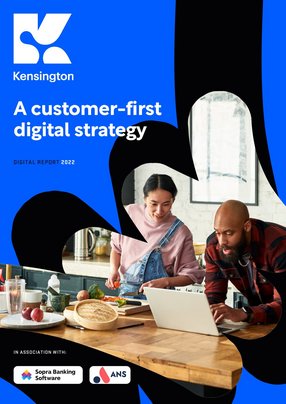Kensington Mortgages: a customer-first digital strategy
When Mark Foulsham joined Kensington Mortgages nearly three-and-a-half years ago, it wasn’t just a new employer – it was a completely new industry. Although he has nearly 20 years of experience in financial services, he had not worked directly in the mortgage sector before, but says the appeal was there from the very beginning. “As an outsider, I thought it was a great opportunity to come in and work with an organisation that was pioneering innovation in the industry,” he recalls.
Foulsham has a superb track record over 25 years of driving digital transformation within senior operations, IT and project delivery roles primarily within financial services. He spent 12 years as CIO at insurance provider Esure Group, including Gocompare, where his remit was broadly similar to his current position, and enjoyed a nearly three-year tenure as Chief Digital Officer for the disability charity Scope. In parallel with that role, he also worked with fintechs on their digital transformation journeys. The cross-fertilisation between sectors provides valuable opportunities for challenge and innovation, he says.
“I've worked across a broad range of industries and that's intentional,” he explains. “I think a variety in your career adds a lot of value for comparing opportunities and looking at how things are done differently. So, my background is quite varied – but deliberately so.”
At Kensington Mortgages, he oversees a full spectrum of operational, digital, data and technology-related functions that make up about two-thirds of the organisation’s headcount and budget. It’s a sizeable undertaking that also includes partnerships and business change – but a role that actually didn’t exist until Foulsham took it up in June 2019. He wasn’t the only new face in the business, either. When Foulsham joined, Chief Executive Mark Arnold was little more than a year into the job. Together with the wider executive team, they have “turbocharged” Kensington’s strategy, reinforcing its position as the UK’s leading specialist provider of mortgages that operates where big-bank lenders struggle to reach.
“The company has been going for 27 years but we’ve changed quite a lot over that period,” Foulsham says. “We are essentially providing mortgages for people who don't necessarily have the right fit of products provided to them by high-street lenders.
“We are actively pioneering in our approach within an industry that continues to be ripe for transformation and disruption; society and customers’ needs continue to evolve to demand more tailored solutions and we are constantly adapting to meet this growing demand. We've led a number of first-time initiatives, including a real focus on ESG – Kensington were the first to complete a green bond securitisation in the UK mortgage market, for instance.
Consumer understanding helps Kensington offer tailored products
At the heart of Kensington’s strategy of specialism is tailoring products to their customers’ individual circumstances. The company prides itself on offering mortgages for those on variable incomes, like sole traders or the self-employed, who have specific lending needs. In particular, it offers a ‘Flexi Fixed For Term mortgage’ that provides certainty of rates to customers in an increasing interest rate environment.
Kensington understands that mortgages are not the sort of product that fit everybody equally. Instead of a one-size-fits-all approach, it invests a great deal of time, analysis and engagement to understand its customers. It’s something that requires empathy – but thankfully, Foulsham can rely on his three adult children, who are of an age to be taking their first steps onto the property ladder. “They provide a great source for challenging my thinking about a generation that’s our future customer base,” he says.
“The large banks are not as nuanced when it comes to connecting the needs of customers with the services and products that they provide,” Foulsham continues. “At Kensington, we have a ‘head-and-heart lending’ mentality, where we use data to provide insight and information but we still make sure that customers’ payment arrangements are at the right level of affordability, or that the right products are tailored for customers. It’s not just about whether the computer says yes or no. It's about really understanding the background and the circumstances of those customers.
“I think if you overplay technology and digital too much in your strategy, you can end up being perceived as a faceless organisation. By combining both tech and the human touch, we try to be highly informed, apply strong diligence and deliver market-leading customer service and solutions. You can only do that by having a real blend of expertise in an organisation. Over the last three years, we've grown significantly year on year. Clearly within that time, we've also had the pandemic to navigate. Despite the challenges COVID-19 brought, it really allowed us to focus on customers’ needs (such as managing payment holidays) and how our colleagues work (replatforming our infrastructure) – and very much acted as a catalyst to what we were doing.
“We put a number of digital solutions in place during the pandemic that we've now continued to use, grown and scaled – but also ways of working as well, whether that comes down to automating some of our activities, greater sophistication around affordability checks or providing a new portal for customers. These are things that not only helped address the specific demands brought by the pandemic, but have now been extended to provide benefits to our customers, brokers and colleagues as we continue to develop further and grow.”
This human touch has built a tangible rapport between Kensington, its broker community and its customers. It will prove enduringly vital as the world faces up to some of its gravest economic realities: consumers are facing a cost-of-living crisis and many homeowners will struggle to pay for everything during the next few months. Foulsham points out that Kensington is well-placed and has proven adaptable in helping them respond to these looming cost pressures.
“People want to have the right service and the right product provided to them, but they also need flexibility and optionality as well. One of the things that we've done is put in a solution that allows customers at the end of their fixed term to choose another product. And we've created that in a digital form, so that when customers move off their fixed rate, we've got clarity on how that can happen and how that can be achieved in the most affordable way for their circumstances.”
Data and technology are fundamental to mitigating risk
Of course, accepting customers that other lenders turn away means a careful understanding of risk is needed – something which Kensington mitigates by utilising the data and technology it has to hand. “Risk is our business,” Foulsham explains wryly. “That's what we manage. Obviously it's the same for high-street lenders. What I would say is, rather than taking a fairly heavy-handed approach, we take a more precise and tailored approach. It's our job to really understand risk, both for our customers and how we underwrite.
“We have a model called VECTOR, which contains mortgage loan level performance data over a period of 30 years and includes 32 million data points through several macroeconomic cycles. The wealth of data allows us to deploy a broad variety of model uses. That ranges from assessing our underwriting accuracy to the effectiveness of pricing for new products.
“Individually, we look at customer circumstances, and I think it's a different type of risk management and risk assessment when customers come to us rather than larger high- street lenders. Because we have the data and the human touch, we can blend those into a better understanding of what risk means to the customer in terms of payment plans, for example, but also risk to us in terms of making sure the loan period is appropriate. In many respects, being more tailored and more personalised in our product set allows us to have greater insight not only into the customer's needs, but also the risks around that.”
Providing a tailored approach also has the potential to create extra work across all areas of business activity. Like many lenders, Kensington has turned to automation to help ease the pain points that this would usually create – but Mark Foulsham is keen to stress that automation needs to be targeted, rather than being a cure-all that can be thrown at any problem.
“I think sometimes automation is seen as a panacea,” he says. “We see it as one of a number of solutions, not a silver bullet.”
“The first question when one deals with automation is ‘are we automating something that is inefficient that needs fixing first?’ So, is the process correct? Is it optimised? Is it effective in terms of providing the right information to customers or the right information back into the organisation? Only when we feel that the process and procedures are correct do we look to automate it to make it slicker. Particularly in areas where there’s no value-add, where you're passing information from one place to another, or when there’s a procedure that you can improve timeliness or accuracy… that's when we look to put in automation.
Digital transformation becomes a lot harder as lenders scale
When you have a mortgage book that’s worth £5bn, as Kensington does, it becomes much more complex for a lender to achieve complexity at scale. New technology and new platforms become mammoth undertakings. Part of the reason that incumbent banks and lenders struggle so much with legacy technology is that, as an organisation scales, it becomes much easier for those at the top of the hierarchy to dismiss large digital transformation projects as too costly, too complex, too time-consuming and too risky.
But, of course, the success that you derive from digital transformation projects relies on the approach you take from the outset, and the partners with whom you choose to align yourself.
“I've always been very keen that you don't continue to just bolt on new things after new,” Foulsham says. “That way, you're just building up technical debt and building up complexity.
“I'm a big believer in reusing your previous investments as well as modularisation of solutions and technology. So, trying to make sure that platforms and systems are coupled in a way that are effective in terms of data transfer and functional cohesion, but aren't too tightly bound in a monolithic sense. That means that every time you make a change, it has a ripple effect and takes a long time to deploy. I think, when we look at scalability and complexity, it comes down to making sure the solutions are as elegant as possible, as simple as possible and no more complicated than they have to be. The market is changing so quickly that if you over-engineer something, you'll find that by the time you've deployed it, the solution isn't actually fit for purpose in a way it was originally.”
Kensington has turned to Paris-based Sopra as its long-time primary technology partner. In recent times, Sopra has deployed a new front-end platform that has allowed Kensington to realise better and more agile working. For example, before that platform came in, it would take many days if not weeks for the lender to effect a pricing change – but Kensington can now do that in minutes or hours.
“We have a very strong relationship with Sopra,” Foulsham says. “We share business strategies, we have good engagement at an executive level, and we deal with making sure that there's a good alignment between their product evolution and our business strategy. So, if we are looking to go into new segments or we're looking to release a new product, the functionality behind that and the way in which their product is going to operate is very much a conversation we have at an early stage with Sopra, so if appropriate they can build that into their core platform.
“In particular, one of the big differences from a few years ago when we were introducing these new platforms is the level of configuration. We are able to configure over 90% of some of the changes that we've put into place, where some of our competitors using other systems have nowhere near that sort of flexibility. Again, it gives us a real advantage in the market using this type of system, a more contemporary system than others. In a dynamic market that requires a quick response to changing circumstances, such as rapidly rising interest rates, having slick and adaptable technology is a real competitive differentiator.”
Key to Kensington’s future lies in core technology partners
It’s this steadfast determination to keep pace with change and move with their customers that underlines much of Kensington’s thinking. Data and technology have taken on renewed importance, allowing the company to tailor products to customers’ individual needs and rapidly transform its technology stack.
“We know that customer circumstances are going to continue to change over the next 12-18 months,” Foulsham says, looking ahead to the next couple of years. “In particular, when it comes to the cost of living, we know that customers are going to want flexibility in the products and services that we provide, so it's really important that we continue to understand what those needs are and be dynamic in the choices we offer.
“As an organisation, it's really important that we continue to look at the changing picture when it comes to our customers’ needs and how we can make sure, as an organisation, we adapt to that evolving position and ultimately provide customers with the value and service that they demand.”




